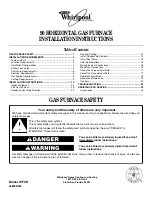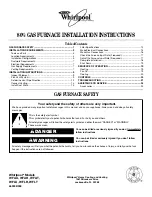
27
Do
not
derate the furnace by adjusting the manifold pressure
to a lower pressure than specified on the furnace rating plate.
The combination of the lower air density and a lower manifold
pressure will prohibit the burner orifice from drawing the prop
-
er amount of air into the burner. This may cause incomplete
combustion, flashback, and possible yellow tipping.
In some areas the gas supplier may artificially derate the gas
in an effort to compensate for the effects of altitude. If the
gas is artificially derated, the appropriate orifice size must be
determined based upon the BTU/ft
3
content of the derated
gas and the altitude. Refer to the National Fuel Gas Code,
NFPA 54/ANSI Z223.1, and information provided by the gas
supplier to determine the proper orifice size.
A different pressure switch may be required at high altitude
regardless of the BTU/ft
3
content of the fuel used. Consult
the furnace Specification Sheet for pressure switch.
WARNING
P
OSSIBLE
PROPERTY
DAMAGE
,
PERSONAL
INJURY
OR
DEATH
MAY
OCCUR
IF
THE
CORRECT
CONVERSION
KITS
ARE
NOT
INSTALLED
. T
HE
APPROPRIATE
KITS
MUST
BE
APPLIED
TO
ENSURE
SAFE
AND
PROPER
FURNACE
OPERATION
. A
LL
CONVERSIONS
MUST
BE
PERFORMED
BY
A
QUALIFIED
INSTALLER
OR
SERVICE
AGENCY
.
Propane Gas Conversion
This unit is configured for natural gas, but may be converted
for use with L.P. gas. Refer to the section on PROPANE GAS/
HIGH ALTITUDE INSTALLATIONS for L.P. kit selection.
When converting to LP gas, it is recommended that an
LPLP0* kit also be installed. The use of this kit will prevent
the furnace from firing when the LP gas supply pressure is
too low to support proper combustion.
Consult the furnace Specification Sheet for a listing of appro
-
priate kits. The indicated kits must be used to insure safe and
proper furnace operation. All conversions must be performed
by a qualified installer, or service agency.
CAUTION
T
O
PREVENT
UNRELIABLE
OPERATION
OR
EQUIPMENT
DAMAGE
,
THE
INLET
GAS
SUPPLY
PRESSURE
MUST
BE
AS
SPECIFIED
ON
THE
UNIT
RATING
PLATE
WITH
ALL
OTHER
HOUSEHOLD
GAS
FIRED
APPLIANCES
OPERATING
.
Gas Valve
This unit is equipped with a 24 volt gas valve controlled
during furnace operation by the integrated control module.
As shipped, the valve is configured for natural gas. The valve
is field convertible for use with propane gas by replacing the
regulator spring with a propane gas spring from an appro
-
priate manufacturer’s propane gas conversion kit. Taps for
measuring the gas supply pressure and manifold pressure
are provided on the valve.
The gas valve has a manual ON/OFF control located on the
valve itself. This control may be set only to the “ON” or “OFF”
position. Refer to the lighting instructions label or
Startup
Procedure & Adjustment
for use of this control during start
up and shut down periods.
Gas Piping Connections
The gas piping supplying the furnace must be properly sized
based on the gas flow required, specific gravity of the gas,
and length of the run. The gas line installation must comply
with local codes, or in their absence, with the latest edition of
the National Fuel Gas Code, NFPA 54/ANSI Z223.1.
Natural Gas Capacity of Pipe
In Cubic Feet of Gas Per Hour (CFH)
Length of
Nominal Black Pipe Size
Pipe in Feet
1/2"
3/4"
1"
1 1/4"
1 1/2"
10
132
278
520
1050
1600
20
92
190
350
730
1100
30
73
152
285
590
980
40
63
130
245
500
760
50
56
115
215
440
670
60
50
105
195
400
610
70
46
96
180
370
560
80
43
90
170
350
530
90
40
84
160
320
490
100
38
79
150
305
460
(Pressure 0.5 psig or less and pressure drop of 0.3" W.C.; Based on
0.60 Specific Gravity Gas)
CFH = BTUH Furnace Input
Heating Value of Gas (BTU/Cubic Foot)
To connect the furnace to the building’s gas piping, the install
-
er must supply a ground joint union, drip leg, manual shutoff
valve, and line and fittings to connect to gas valve. In some
cases, the installer may also need to supply a transition piece
from 1/2” pipe to a larger pipe size.
The following stipulations apply when connecting gas piping.
Refer to
Gas Piping Connections
figure for typical gas line
connections to the furnace.
• Gas piping must be supported external to the furnace
cabinet so that the weight of the gas line does not
distort the burner rack, manifold or gas valve.
•
Use black iron or steel pipe and fittings for building
piping. Where possible, use new pipe that is properly
chamfered, reamed, and free of burrs and chips. If old
pipe is used, be sure it is clean and free of rust, scale,
burrs, chips, and old pipe joint compound.
•
Use pipe joint compound on male threads ONLY.
Always use pipe joint compound (pipe dope) that
is APPROVED FOR ALL GASES. DO NOT apply
compound to the first two threads.
•
Use ground joint unions.
•
Install a drip leg to trap dirt and moisture before it can
enter the gas valve. The drip leg must be a minimum
of three inches long.
•
Install a 1/8” NPT pipe plug fitting, accessible for test
gage connection, immediately upstream of the gas
supply connection to the furnace.
















































